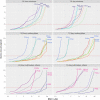Per- and polyfluoroalkyl substances (PFAS) in mixtures show additive effects on transcriptomic points of departure in human liver spheroids
- PMID: 37195416
- PMCID: PMC10306399
- DOI: 10.1093/toxsci/kfad044
Per- and polyfluoroalkyl substances (PFAS) in mixtures show additive effects on transcriptomic points of departure in human liver spheroids
Abstract
Per- and polyfluoroalkyl substances (PFAS) are a wide range of chemicals that are used in a variety of consumer and industrial products leading to direct human exposure. Many PFAS are chemically nonreactive and persistent in the environment, resulting in additional exposure from water, soil, and dietary intake. While some PFAS have documented negative health effects, data on simultaneous exposures to multiple PFAS (PFAS mixtures) are inadequate for making informed decisions for risk assessment. The current study leverages data from previous work in our group using Templated Oligo-Sequencing (TempO-Seq) for high-throughput transcriptomic analysis of PFAS-exposed primary human liver cell spheroids; herein, we determine the transcriptomic potency of PFAS in mixtures. Gene expression data from single PFAS and mixture exposures of liver cell spheroids were subject to benchmark concentration (BMC) analysis. We used the 25th lowest gene BMC as the point of departure to compare the potencies of single PFAS to PFAS mixtures of varying complexity and composition. Specifically, the empirical potency of 8 PFAS mixtures were compared to predicted mixture potencies calculated using the principal of concentration addition (ie, dose addition) in which mixture component potencies are summed by proportion to predict mixture potency. In this study, for most mixtures, empirical mixture potencies were comparable to potencies calculated through concentration addition. This work supports that the effects of PFAS mixtures on gene expression largely follow the concentration addition predicted response and suggests that effects of these individual PFAS in mixtures are not strongly synergistic or antagonistic.
Keywords: PFAS; TempO-Seq; benchmark concentration; liver spheroids; mixture toxicity; new approach methodology.
© Her Majesty the Queen in Right of Canada 2023. Reproduced with the permission of the Minister of Health.
Figures






References
-
- Altenburger R., Backhaus T., Boedeker W., Faust M., Scholze M., Grimme L. H. (2000). Predictability of the toxicity of multiple chemical mixtures to Vibrio fischeri: Mixtures composed of similarly acting chemicals. Environ. Toxicol. Chem. 19, 2341–2347.
-
- Auerbach S., Parham F., Wolfe M., and Bucher J. (2018). National Toxicology Program. NTP Research Report on National Toxicology Program Approach to Genomic Dose-Response Modeling: Research Report 5, National Toxicology Program, Durham, NC. - PubMed
-
- Backhaus T., Altenburger R., Boedeker W., Faust M., Scholze M., Grimme L. H. (2000). Predictability of the toxicity of a multiple mixture of dissimilarly acting chemicals to Vibrio fischeri. Environ. Toxicol. Chem. 19, 2348–2356.
-
- Behr A.-C., Plinsch C., Braeuning A., Buhrke T. (2020). Activation of human nuclear receptors by perfluoroalkylated substances (PFAS). Toxicol. In Vitro 62, 104700. - PubMed
Publication types
MeSH terms
Substances
Associated data
LinkOut - more resources
Full Text Sources
Other Literature Sources

